
The Battle of Fredericksburg was fought December 11–15, 1862, in and around Fredericksburg, Virginia, in the Eastern Theater of the American Civil War. The combat between the Union Army of the Potomac commanded by Maj. Gen. Ambrose Burnside and the Confederate Army of Northern Virginia under Gen. Robert E. Lee included futile frontal attacks by the Union army on December 13 against entrenched Confederate defenders along the Sunken Wall on the heights behind the city. It is remembered as one of the most one-sided battles of the war, with Union casualties more than twice as heavy as those suffered by the Confederates. A visitor to the battlefield described the battle as a "butchery" to U.S. President Abraham Lincoln.

The Army of Northern Virginia was the primary military force of the Confederate States of America in the Eastern Theater of the American Civil War. It was also the primary command structure of the Department of Northern Virginia. It was most often arrayed against the Union Army of the Potomac.

The Richmond–Petersburg campaign was a series of battles around Petersburg, Virginia, fought from June 9, 1864, to March 25, 1865, during the American Civil War. Although it is more popularly known as the siege of Petersburg, it was not a classic military siege, in which a city is encircled with fortifications blocking all routes of ingress and egress, nor was it strictly limited to actions against Petersburg. The campaign consisted of nine months of trench warfare in which Union forces commanded by Lieutenant General Ulysses S. Grant assaulted Petersburg unsuccessfully and then constructed trench lines that eventually extended over 30 miles (48 km) from the eastern outskirts of Richmond, Virginia, to around the eastern and southern outskirts of Petersburg. Petersburg was crucial to the supply of Confederate General Robert E. Lee's army and the Confederate capital of Richmond. Numerous raids were conducted and battles fought in attempts to cut off the Richmond and Petersburg Railroad. Many of these battles caused the lengthening of the trench lines.
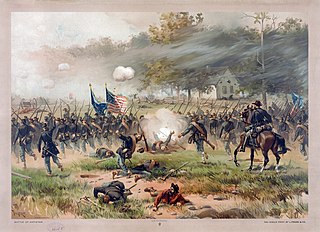
The Battle of Antietam, also called the Battle of Sharpsburg, particularly in the Southern United States, took place during the American Civil War on September 17, 1862, between Confederate General Robert E. Lee's Army of Northern Virginia and Union Major General George B. McClellan's Army of the Potomac near Sharpsburg, Maryland, and Antietam Creek. Part of the Maryland Campaign, it was the first field army–level engagement in the Eastern Theater of the American Civil War to take place on Union soil. It remains the bloodiest day in American history, with a tally of 22,727 dead, wounded, or missing on both sides. Although the Union Army suffered heavier casualties than the Confederates, the battle was a major turning point in the Union's favor.

Burkittsville is a historic village in Frederick County, Maryland, United States. The village lies in the southern Middletown Valley along the eastern base of South Mountain.
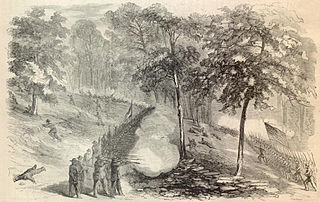
The Battle of South Mountain, known in several early Southern accounts as the Battle of Boonsboro Gap, was fought on September 14, 1862, as part of the Maryland campaign of the American Civil War. Three pitched battles were fought for possession of three South Mountain passes: Crampton's, Turner's, and Fox's Gaps.
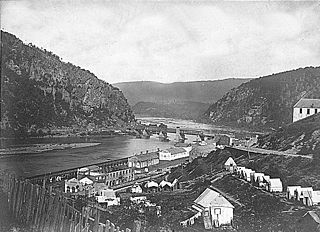
The Battle of Harpers Ferry was fought September 12–15, 1862, as part of the Maryland Campaign of the American Civil War. As Confederate Army General Robert E. Lee's Confederate army invaded Maryland, a portion of his army under Major General Thomas J. "Stonewall" Jackson surrounded, bombarded, and captured the Union garrison at Harpers Ferry, Virginia.

The Battle of Seven Pines, also known as the Battle of Fair Oaks or Fair Oaks Station, took place on May 31 and June 1, 1862, in Henrico County, Virginia as part of the Peninsula Campaign of the American Civil War.
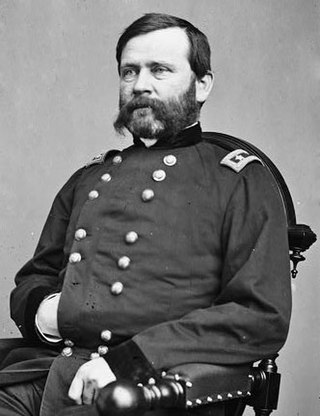
William Buel Franklin was a career United States Army officer and a Union Army general in the American Civil War. He rose to the rank of a corps commander in the Army of the Potomac, fighting in several notable battles in the Eastern Theater of the Civil War. He also distinguished himself as a civil engineer before and after the war.

The VI Corps was a corps of the Union Army during the American Civil War.

The Northern Virginia Campaign, also known as the Second Bull Run Campaign or Second Manassas Campaign, was a series of battles fought in Virginia during August and September 1862 in the Eastern Theater of the American Civil War. Confederate General Robert E. Lee followed up his successes of the Seven Days Battles in the Peninsula campaign by moving north toward Washington, D.C., and defeating Maj. Gen. John Pope and his Army of Virginia.

The Maryland campaign occurred September 4–20, 1862, during the American Civil War. The campaign was Confederate General Robert E. Lee's first invasion of the North. It was repulsed by the Army of the Potomac under Maj. Gen. George B. McClellan, who moved to intercept Lee and his Army of Northern Virginia and eventually attacked it near Sharpsburg, Maryland. The resulting Battle of Antietam was the bloodiest day of battle in American history.
The Battle of Jerusalem Plank Road, also known as the First Battle of the Weldon Railroad, took place during the American Civil War fought June 21–23, 1864, near Petersburg, Virginia. It was the first of a series of battles during the Siege of Petersburg aimed at extending the Union siege lines to the west and cutting the rail lines supplying Petersburg. Two infantry corps of the Union Army of the Potomac attempted to sever the Weldon Railroad, but were attacked and driven off by the Confederate Army of Northern Virginia's Third Corps, principally the division of Brig. Gen. William Mahone. The inconclusive battle left the Weldon Railroad temporarily in Confederate hands, but the Union Army began to extend its fortifications to the west, starting to increase the pressure of the siege.

During the second day of the Battle of Gettysburg Confederate Gen. Robert E. Lee attempted to capitalize on his first day's accomplishments. His Army of Northern Virginia launched multiple attacks on the flanks of the Union Army of the Potomac, commanded by Maj. Gen. George G. Meade. The assaults were unsuccessful, and resulted in heavy casualties for both sides.

The eastern theater of the American Civil War consisted of the major military and naval operations in the states of Virginia, West Virginia, Maryland, and Pennsylvania, the national capital in Washington, D.C., and the coastal fortifications and seaports of North Carolina. The interior of the Carolinas were considered part of the western theater, and other coastal areas along the Atlantic Ocean were part of the lower seaboard theater.
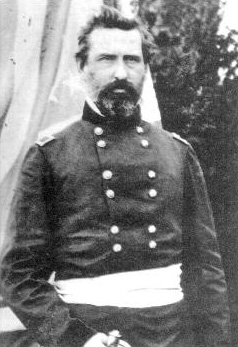
William Thomas Harbaugh Brooks was a career military officer in the United States Army, serving as a major general during the American Civil War.
The 2nd Maryland Infantry was an American military regiment in the Union Army during the American Civil War. It should not be confused with the 2nd Maryland Infantry, CSA, which was composed of Maryland volunteers who fought for the Confederacy during the war. The regiment fought at numerous battles during the course of the war, and lost 5 officers and 84 men killed and wounded, plus 3 officers and 134 men died of disease, for a total of 226 casualties.
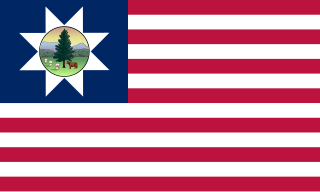
The 6th Vermont Infantry Regiment was a three years' infantry regiment in the Union Army during the American Civil War. Organized at Montpelier and mustered in October 15, it served in the Army of the Potomac (AoP). It departed Vermont for Washington, DC, October 19, 1861. It served in the Eastern Theater, predominantly in the VI Corps, AoP, from October 1861 to June 1865. It was a part of the Vermont Brigade.

The Confederate Army of Northern Virginia began its Retreat from Gettysburg on July 4, 1863. Following General Robert E. Lee's failure to defeat the Union Army at the Battle of Gettysburg, he ordered a retreat through Maryland and over the Potomac River to relative safety in Virginia.

The 1st Massachusetts Battery was a peacetime militia artillery battery that was activated for federal service in the Union army for two separate tours during the American Civil War. Prior to the war and during its first term of service, the unit was sometimes known as "Cook's Battery" after its commanding officer, Capt. Asa M. Cook. During its first term, the battery primarily served garrison duty in Baltimore, Maryland. Almost immediately after mustering out, the unit began preparing for a second term, this time volunteering to serve for three years. The battery was attached to the VI Corps of the Army of the Potomac during its second term and took part in some of the largest battles of the war including the Fredericksburg, Chancellorsville, Gettysburg, and Lieutenant General Ulysses S. Grant's Overland Campaign in the spring of 1864.




















